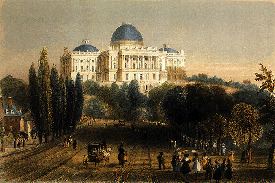The Twenty-fifth United States Congress was a meeting of the legislative branch of the United States federal government, consisting of the United States Senate and the United States House of Representatives. It met in Washington, D.C. from March 4, 1837 to March 4, 1839, during the first two years of Martin Van Buren's presidency. The apportionment of seats in the House of Representatives was based on the Fifth Census of the United States in 1830. Both chambers had a Democratic majority.
March 4, 1837: Martin Van Buren became President of the United StatesMay 10, 1837: Panic of 1837January 6, 1838: First public demonstration of Samuel Morse's telegraphMay 26, 1838: Trail of Tears: The Cherokee removal began[Data unknown/missing. You can help!]States admitted and/or territories organized
June 12, 1838: Iowa Territory was formed from the Wisconsin Territory.President: Richard Mentor Johnson (D)President pro tempore: William R. King (D)Speaker: James K. Polk (D)This list is arranged by chamber, then by state. Senators are listed in order of seniority, and Representatives are listed by district.
Skip to House of Representatives, belowSenators were elected by the state legislatures every two years, with one-third beginning new six-year terms with each Congress. Preceding the names in the list below are Senate class numbers, which indicate the cycle of their election. In this Congress, Class 1 meant their term ended with this Congress, requiring reelection in 1838; Class 2 meant their term began in the last Congress, requiring reelection in 1840; and Class 3 meant their term began in this Congress, requiring reelection in 1842.
The names of members of the House of Representatives are preceded by their district numbers.
The count below reflects changes from the beginning of the first session of this Congress.
Replacements: 6Democrats: no net changeWhigs: no net changeDeaths: 1Resignations: 6Total seats with changes: 7Replacements: 16Democrats: 5-seat net lossWhigs: 5-seat net gainDeaths: 9Resignations: 6Contested election:1Total seats with changes: 20Lists of committees and their party leaders.
AgricultureAudit and Control the Contingent Expenses of the SenateClaimsCommerceDanger of Steam Vessels (Select)Distributing Public Revenue Among the States (Select)District of ColumbiaFinanceForeign RelationsIndian AffairsJudiciaryLetter of Mr. Ruggles (Select)ManufacturesMemorial of A. B. Quinby (Select)Memorial of the Citizens of Georgetown (DC) for the Retrocession of that Part of the District (Select)Memorial of Duff Green (Select)Memorial of Edward D. Tippett (Select)Mileage of Members of Congress (Select)Military AffairsMilitiaNaval AffairsOccupation of the Columbia River (Select)Oregon Territory (Select)Patents and the Patent OfficePensionsPost Office and Post RoadsPrivate Land ClaimsPublic Buildings and GroundsPublic LandsPurchasing Boyd Reilly's Gas Apparatus (Select)Revolutionary ClaimsRoads and CanalsTariff Regulation (Select)WholeAccountsAgricultureAmendment to the Constitution (Select)ClaimsCommerceDistrict of ColumbiaElectionsExpenditures in the Navy DepartmentExpenditures in the Post Office DepartmentExpenditures in the State DepartmentExpenditures in the Treasury DepartmentExpenditures in the War DepartmentExpenditures on Public BuildingsForeign AffairsIndian AffairsInvalid PensionsManufacturesMileageMilitary AffairsMilitiaNaval AffairsPatentsPost Office and Post RoadsPublic Buildings and GroundsPublic ExpendituresPublic LandsRevisal and Unfinished BusinessRevolutionary ClaimsRoads and CanalsRules (Select)Standards of Official ConductTerritoriesWays and MeansWholeEnrolled BillsLibrarian of Congress: John Silva MeehanChaplain: John R. Goodman (Episcopalian), elected December 28, 1836Henry Slicer (Methodist), elected September 11, 1837Secretary: Asbury DickensSergeant at Arms: John Shackford (died)Stephen Haight, elected September 4, 1837Chaplain: Septimus Tustin (Presbyterian), elected September 4, 1837Levi R. Reese (Methodist), elected December 4, 1837Clerk: Walter S. Franklin, until September 20, 1838 (died)Hugh A. Garland, elected December 3, 1838Doorkeeper: Overton CarrPostmaster: William J. McCormickSergeant at Arms: Roderick Dorsey 
